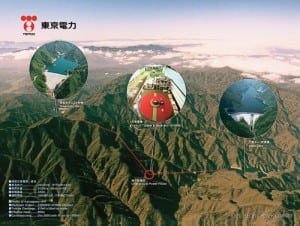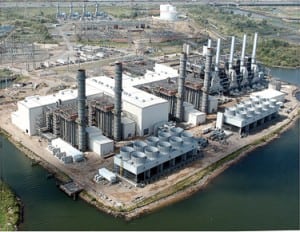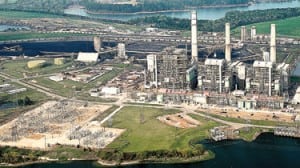-
Coal
Currant Creek Power Plant, Mona, Utah
Commercial operation of PacifiCorp’s first new power plant in more than 20 years coincided with the company’s acquisition by MidAmerican Energy Holdings Company this past March. Currant Creek treads lightly on the environment, provides needed power to PacifiCorp’s eastern control area, and has demonstrated its commitment to be a good corporate citizen of the local community. By any account, Currant Creek is a model for how to develop a power project.
-
Hydro
Kannagawa Hydropower Plant, Japan
With the commercial debut of the first of six planned 470-MW turbines in December 2005, the time has come to pay homage to the sheer size (2,820 MW) and longevity (13 years and counting) of TEPCO’s Kannagawa Hydropower Plant. By the time Unit 2 is commissioned in 2010, and Units 3 through 6 go on-line "in and after 2016," two generations of engineers, technicians, and builders will have worked on the "pure" pumped-storage project since its inception. As if those stats weren’t impressive enough, Kannagawa marks the debut of "splitter runners" for pump-turbines. They increase the effective head of the plant to the highest in the world: 2,142 feet, at a flow of 135,000 gallons/second. That’s a very large pump-turbine, indeed.
-
Gas
Linden Generating Station, Linden, New Jersey
It would be easy to dismiss Linden—which is powered by now-ubiquitous GE 7FA gas turbines and D11 steam turbines—as just another cookie-cutter combined-cycle plant. But its size (1,240 MW), key location near New York City, and use of reclaimed water for all cooling water needs makes Linden deserving of recognition as one of POWER’s Top Plants of 2006. Perhaps its most interesting story is how the project survived more than five years from groundbreaking to commissioning.
-
Coal
Monticello Steam Electric Station, Mount Pleasant, Texas
Why does Monticello, a 30-year-old plant, deserve recognition as one of POWER’s Top Plants of 2006? Because TXU has been blending Powder River Basin (PRB) coal with local lignite at the plant for the past decade, and steady reductions in air-pollutant emission rates have been the result. That positive experience has made the company confident enough to propose building nearly 9,100 MW of new coal- or lignite-fired capacity in Texas by 2010 at a cost of $10 billion. Read on to share some of the lessons that TXU has learned about handling PRB coal safely.
-
News
Banana republic
Learning theorists tell us that one of the key reasons we don’t learn from our mistakes is that we don’t or won’t recognize them as such. We attribute good outcomes to our skill and intelligence and blame bad ones on others or on just plain bad luck. This unhealthy mind-set can be tolerated for […]
-
Gas
Mountainview Power Plant, Redlands, California
Southern California Edison and Bechtel resurrected the 1,054-MW Mountainview power project after a two-year hiatus while meeting aggressive budget and schedule constraints. Edison exercised its option to purchase the project after regulatory approvals were received at light speed, and construction resumed the very day approval was granted. Residents of California’s Inland Empire will enjoy their air conditioners this summer because Mountainview was transformed from a wasteland into a productive plant.
-
Gas
Global Monitor (July/August 2006)
Russia’s new nuclear navy;Russia’s old nuclear navy; First LMS100 fired up by Basin Electric;More Jenbacher gensets to Hungary; A baseload-size wind farm?; EEI bestows Edison Awards; POWERnotes
-
Gas
NYPA Astoria Project, Astoria, New York
New York City has an insatiable appetite for power, but supplying that power from plants inside the city’s five boroughs (where 80% of its peak demand must come from) is tough. So it’s nothing short of miraculous that a 500-MW combined-cycle plant in Astoria, Queens, began commercial operation at the end of 2005. What did it take to bring this plant on-line? The largest state-owned power organization in the U.S.—The New York Power Authority.
-
O&M
Profiling your plant engineering staff
The latest benchmarking study by the EUCG examines the engineering and technical staffing of 62 plants, 92% of which burn coal. If you benchmark your units, plants, or fleet, the results may raise some eyebrows. But they also may help justify your plea for more intellectual capital during the upcoming budgeting cycle. Though the detailed results of the study are proprietary to EUCG member companies that participated in it, POWER was given access to the complete findings. If you want details at the plant/unit level, you’ll have to join the EUCG and participate in the study, which is ongoing.
-
Solar
Saguaro Solar Power Plant, Red Rock, Arizona
We tend to forget that today’s super-sized power plant designs began life as small prototypes that grew in size only as fast as technology and economics allowed. Arizona Public Service, a long-time leader in solar energy development, has invested in the development of one such technology that is compatible with the sunny Southwest and certain to become more cost-competitive in the near future. This successful demonstration of a 1-MW concentrated solar power, trough-style energy system is the first to have put power on the grid since 1988. But it certainly won’t be the last.
Search











